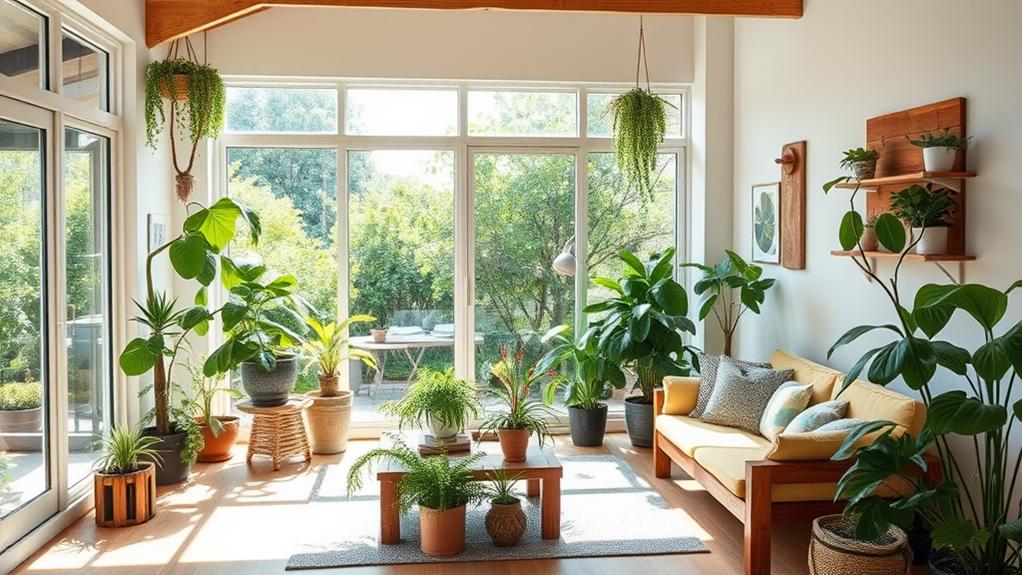You might think eco-friendly projects are complicated or time-consuming, but they can actually be both simple and rewarding. By integrating sustainability into your home, you not only enhance your living space but also contribute to a healthier planet. Imagine transforming old furniture into stylish pieces or creating eye-catching wall art from recycled materials. There's a range of innovative projects that can fit seamlessly into your modern lifestyle, making sustainability accessible and practical. Curious about how these ideas can elevate your home while being kind to the environment? Let's explore the possibilities.
Upcycled Furniture Innovations
Upcycled furniture innovations breathe new life into old pieces, transforming what might be discarded into functional art. You can create stunning furniture that reflects your style while reducing waste and saving money.
Start by exploring what you already have: a worn-out chair, a vintage dresser, or even pallets from a local store.
Consider a few simple projects. For instance, you could turn an old ladder into a unique bookshelf, adding character to your living room. If you've got a vintage suitcase, stack it to form a trendy side table. The possibilities are endless!
Don't forget about paint and fabric; these can dramatically change the look and feel of your furniture. A fresh coat of eco-friendly paint or some new upholstery can revitalize tired pieces. Plus, you can personalize them to fit your home's aesthetic.
While working on these projects, you'll not only release your creativity but also engage in sustainable practices. By upcycling, you're reducing landfill waste and embracing a more eco-conscious lifestyle.
Solar-Powered Garden Lights
Transforming your outdoor space can be as simple as adding solar-powered garden lights, which not only enhance the atmosphere but also promote sustainability.
These lights harness solar energy during the day and illuminate your garden at night, reducing your electricity bill and carbon footprint.
Installing solar-powered lights is a straightforward DIY project. Start by selecting locations that receive ample sunlight throughout the day. You can choose from various styles, including pathway lights, spotlights, and decorative lanterns, allowing you to create a personalized ambiance.
Simply stake them into the ground or mount them on walls, depending on your design preference.
Maintenance is minimal, too. Just periodically clean the solar panels to verify they're absorbing sunlight efficiently. If any bulbs burn out, you can easily replace them without needing complex wiring.
Not only do these lights improve your garden's aesthetics, but they also provide safety and security. By illuminating pathways and dark corners, you'll prevent accidents and deter unwanted visitors.
Plus, the warm glow adds charm to your outdoor gatherings. So, embrace the eco-friendly trend and light up your garden with solar-powered solutions!
Smart Thermostat Installation
When you want to save energy and money while enhancing your home's comfort, installing a smart thermostat is a fantastic DIY project. These devices allow you to control your heating and cooling remotely, optimizing energy usage based on your lifestyle.
To get started, you'll need a smart thermostat compatible with your HVAC system. Begin by turning off the power to your heating and cooling systems at the circuit breaker. Remove the old thermostat carefully, taking note of the wire connections. Most smart thermostats come with a color-coded guide to help you connect the wires correctly.
Once you've attached the new thermostat to the wall, follow the manufacturer's instructions to connect the wires. After securing the thermostat, restore power and complete the setup through the corresponding app on your smartphone.
You'll appreciate features like scheduling and energy usage reports, which help you make informed decisions.
Rainwater Harvesting Systems
Rainwater harvesting systems are an effective way to conserve water and reduce your utility bills. By collecting rainwater from your roof and storing it for later use, you can harness a natural resource that often goes to waste. Setting up a system isn't as complicated as it may seem.
Start by installing gutters and downspouts to channel rainwater into a storage tank. Make certain the tank is made of food-grade material to guarantee the water remains clean and safe for gardening or household tasks. You can choose between above-ground or underground tanks based on your space and aesthetic preferences.
Next, consider adding a filtration system to remove debris and contaminants before using the collected water. Regular maintenance, like cleaning your gutters and checking for leaks, will keep your system running smoothly.
With a rainwater harvesting system, you not only save money but also contribute to environmental sustainability. Plus, using harvested rainwater for irrigation helps reduce the stress on municipal water supplies, especially during dry spells.
Recycled Material Wall Art
Creating wall art from recycled materials is a fun and sustainable way to express your creativity while reducing waste. You can transform old newspapers, magazines, scrap wood, or even discarded plastic into unique pieces that reflect your style. Start by gathering materials you already have at home.
Here's a quick table to inspire your projects:
| Material | Project Idea | Tips |
|---|---|---|
| Old magazines | Collage art | Use a strong adhesive |
| Scrap wood | Wooden wall hanging | Sand edges for safety |
| Plastic bottles | 3D wall sculpture | Cut and shape creatively |
| Fabric scraps | Textile wall art | Mix colors for vibrancy |
| Cardboard boxes | Geometric shapes | Paint for added flair |
Choose a style that resonates with you, whether minimalist or eclectic. Don't hesitate to combine materials for added texture and depth. Once you've created your masterpiece, hang it up and enjoy the conversation it sparks. Not only will you beautify your space, but you'll also contribute to a greener planet. Get started today!
Energy-Efficient Window Treatments
A variety of energy-efficient window treatments can dramatically reduce your energy bills while enhancing your home's comfort.
By choosing the right options, you can keep your space cooler in the summer and warmer in the winter, all while adding a stylish touch to your decor.
Here are some effective treatments to evaluate:
- Cellular Shades: These create air pockets that provide insulation, keeping your home at a comfortable temperature year-round.
- Blackout Curtains: Not only do they block light, but they also reduce heat loss considerably, especially during the colder months.
- Solar Shades: Designed to filter sunlight while maintaining your view, they help lower cooling costs by reducing heat gain without sacrificing natural light.
- Window Films: These can be applied directly to glass surfaces, reflecting heat and UV rays, which protects your furnishings and reduces energy usage.
DIY Compost Bins
Energy-efficient homes not only save on utility bills but can also embrace sustainable practices like composting.
Creating your own DIY compost bin is a simple yet impactful way to reduce waste and enrich your garden soil. You don't need fancy materials; you can use items you likely already have at home.
Start by selecting a location in your yard, ideally a spot that's easy to access and has good drainage. For the bin itself, you can repurpose a wooden pallet or an old trash can. If you're using a trash can, drill holes in the sides for airflow.
Next, layer your compost materials. Combine green materials like vegetable scraps and grass clippings with brown materials such as dried leaves and cardboard. Aim for a balance—too much of one type can slow down the composting process.
Regularly turn the pile to aerate it and speed up decomposition.
In just a few months, you'll have rich compost ready to nourish your plants. Not only will you reduce waste, but you'll also contribute to a healthier environment by recycling nutrients back into the earth.
Enjoy the satisfaction of creating something beneficial!
Low-VOC Paint Projects
Transforming your living space with low-VOC paint not only brightens up your home but also promotes a healthier indoor environment.
Volatile organic compounds (VOCs) emitted from traditional paints can negatively impact air quality and your health. By opting for low-VOC alternatives, you reduce these risks while still achieving stunning results.
Here are some fun projects you can tackle using low-VOC paint:
- Accent Walls: Choose a bold color to create an accent wall that draws attention and adds character to your space.
- Furniture Makeover: Revitalize old furniture with a fresh coat of low-VOC paint, giving it new life while keeping your indoor air healthy.
- DIY Artwork: Get creative and paint your own art pieces. You'll personalize your decor while ensuring a safe environment.
- Kids' Rooms: Use low-VOC paint for children's spaces; it's safer for their developing lungs and allows for fun color choices.
Eco-Friendly Insulation Solutions
When it comes to making your home more sustainable, eco-friendly insulation solutions can greatly enhance energy efficiency while reducing your carbon footprint. You have several options to choose from, depending on your budget and preferences.
One popular choice is cellulose insulation, made from recycled paper products. It's a fantastic option because it's not only effective but also minimizes waste.
Another great alternative is sheep's wool, which offers natural breathability and excellent thermal performance. Plus, it's renewable and biodegradable.
If you're looking for something more unconventional, consider using denim insulation, which repurposes old jeans. It's safe, effective, and adds a unique touch to your home.
For those wanting to go a step further, spray foam insulation made from natural materials can seal gaps and improve energy efficiency.
Don't forget about the importance of air sealing. Properly sealing windows and doors prevents drafts and enhances your insulation's effectiveness.
Smart Home Energy Monitors
Smart home energy monitors are game-changers for anyone looking to track and optimize their energy usage.
These devices give you in-depth insights into your home's energy consumption, helping you make informed decisions to reduce waste and save on bills. By using a smart energy monitor, you can easily identify which appliances are energy hogs and adjust your habits accordingly.
Here are a few benefits of using a smart home energy monitor:
- Real-Time Data: Get instant feedback on your energy usage, allowing you to make immediate adjustments.
- Cost Savings: By identifying and reducing unnecessary energy use, you can lower your utility bills.
- Environmental Impact: Cut down on energy waste, reducing your carbon footprint and contributing to a healthier planet.
- Remote Monitoring: Use mobile apps to track your energy consumption from anywhere, making it easier to stay on top of your usage.
Incorporating a smart home energy monitor into your eco-friendly DIY projects not only enhances your home's efficiency but also empowers you to live more sustainably.
Start monitoring today and take control of your energy future!
Conclusion
By embracing these eco-friendly DIY projects, you're not just enhancing your home but also making a positive impact on the planet. Did you know that using low-VOC paints can reduce indoor air pollution by up to 80%? It's a simple change that leads to healthier living spaces. So, gather your materials and get creative—every small effort counts toward a more sustainable lifestyle. Let's transform our homes into eco-friendly havens together!











